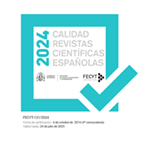La Federación Comunista Catalano Balear: origen, polémicas e implantación territorial (1923-1932)
Resumen
El presente trabajo indaga en los orígenes, desarrollo y desaparición de la Federación Comunista Catalano Balear (FCCB), poniendo el acento no únicamente en sus propuestas políticas y complejas relaciones con el Partido Comunista de España (PCE), sino también en las consecuciones y límites de su despliegue organizativo en los dos territorios en los que estuvo implantada. Orgaizada en 1923 como sección territorial del PCE que agrupaba a los comunistas de Cataluña y de las Baleares, desde el otoño de 1924 se articuló en esencia en torno al «Grupo de la Batalla» –la corriente sindicalista revolucionaria de la CNT, dirigida por Joaquín Maurín–, mientras que la aportación inicial de los núcleos preexistentes del PCE tanto en el Principado como en el archipiélago quedó muy diluida. El nuevo organismo, muy marcado por una cultura política diferente a la del grueso del comunismo hispánico, entró pronto en colisión con la dirección central del PCE en un contexto marcado por las controversias que sacudieron al movimiento comunista internacional tras la muerte de Lenin. En 1930/31 la FCCB rompió definitivamente con el PCE e impulsó la formación del Bloque Obrero y Campesino (BOC), del que surgiría cuatro años más tarde el partido Obrero de Unificación Marxista (POUM). El uso de prensa periódica y de informes internos del archivo del Partido Comunista de España permite profundizar particularmente en los conflictos desarrollados entre la FCCB y el PCE, así como en las relaciones –hasta ahora muy poco conocidas– que se establecieron entre los comunistas catalanes y mallorquines.
Descargas
Descarga artículo
Licencia
La revista Cuadernos de Historia Contemporánea, para fomentar el intercambio global del conocimiento, facilita el acceso sin restricciones a sus contenidos desde el momento de su publicación en la presente edición electrónica, y por eso es una revista de acceso abierto. Los originales publicados en esta revista son propiedad de la Universidad Complutense de Madrid y es obligatorio citar su procedencia en cualquier reproducción total o parcial. Todos los contenidos se distribuyen bajo una licencia de uso y distribución Creative Commons Reconocimiento 4.0 (CC BY 4.0). Esta circunstancia ha de hacerse constar expresamente de esta forma cuando sea necesario. Puede consultar la versión informativa y el texto legal de la licencia.











